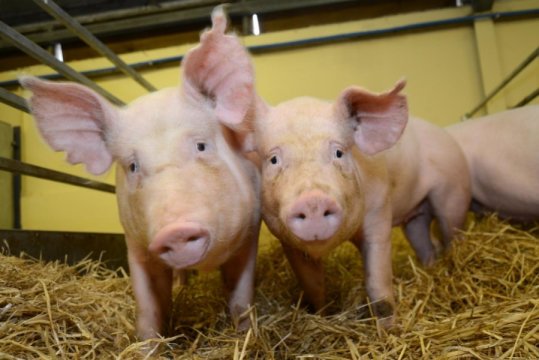[ad_1]
Scientists have produced pigs that can resist one of the world’s most costly animal diseases, by changing their genetic code.
Tests with the virus — called Porcine Reproductive and Respiratory Syndrome, or PRRS — found the pigs do not become infected at all.
The animals show no signs that the change in their DNA has had any other impact on their health or wellbeing.
PRRS costs the pig industry around $2.5 billion (£1.75bn) each year in lost revenue in the US and Europe alone.
The disease causes breathing problems and deaths in young animals and if pregnant sows become infected, it can cause them to lose their litter.
The virus infects pigs using a receptor on their cells’ surface called CD163. Researchers at the University of Edinburgh’s Roslin Institute used gene editing techniques to remove a small section of the CD163 gene.
They focused on the section of the receptor that the virus attaches to, leaving the rest of the molecule intact.
The team collaborated with Genus PLC, a leading global animal genetics company, to produce pigs with the specific DNA change.
Previous studies had shown that cells from these animals were resistant to the virus in lab tests.
This is the first time researchers have exposed these pigs to the virus to see if they become infected.
They found that none of the animals became ill when exposed to the virus. Blood tests found no trace of the infection.
This research, co-funded by the Biotechnology and Biological Sciences Research Council and Genus PLC, is published in the Journal of Virology.
PRRS is endemic in most pig producing countries worldwide. Vaccines have mostly failed to stop the spread of the virus — which continues to evolve rapidly.
Other groups have used gene editing to create PRRS-resistant pigs by removing the whole CD163 receptor.
Removing only a section of CD163 allows the receptor to retain its ordinary function in the body and reduces the risk of side effects, the researchers say.
Dr Christine Tait-Burkard, of the University of Edinburgh’s Roslin Institute, said: “These results are exciting but it will still likely be several years before we’re eating bacon sandwiches from PRRS-resistant pigs.
“First and foremost we need broader public discussion on the acceptability of gene-edited meat entering our food chain, to help inform political leaders on how these techniques should be regulated.
“We also need to carry out longer term studies to confirm that these genetic changes do not have any unforeseen adverse effects on the animals.
“If these studies are successful and the public are accepting of this technology, we would then be looking to work with pig breeding companies to integrate these gene edits into commercial breeding stocks.”
Genetically modified animals are banned from the food chain in Europe. It is not clear what regulations would apply to gene-edited animals, however, as the approach is different.
GM techniques have been controversial because they can involve introducing genes of other species into an animal. In contrast, gene editing speeds up processes that could occur naturally through breeding over many generations, without introducing genes from other species.
Professor Alan Archibald said: “Gene editing gives us a powerful tool to help reduce losses in the farming industry while improving the health and welfare of the animals themselves.”
Jonathan Lightner, Chief Scientific Officer for Genus PLC said: “These results are very exciting and further underscore the potential, through gene editing, to provide incredible benefits to the global pork industry, and society as a whole, by improving animal health. We look forward to further collaboration with the University on this exciting project.”
The interdisciplinary research is the result of long term strategic investment from the BBSRC.
Jef Grainger, Associate Director of BBSRC Science Strategy, said: “This is an exciting result that demonstrates the potential for genome editing approaches to enable significant improvements to be made in the health and welfare of farmed animals, and reduce the economic impacts of diseases that are otherwise difficult to manage effectively.”
[ad_2]















